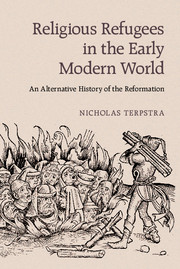3 - Dividing the Body: People and Places
Published online by Cambridge University Press: 05 August 2015
Summary
Religiously driven exile may have emerged as a mass phenomenon in the early modern period, but how did individuals experience it? What was it like to look at the world from the position of the religious refugee? By comparing the experiences of a range of individuals from across different faiths, we can begin to put a human face on what was often an inhuman tragedy. Some weathered this better than others, and all were deeply marked by it. In many cases, removal was not a one-time thing. Some moved frequently in search of a place that would allow them to build a community. Others found that community and turned it into a test case for ideas and an incubator for missionary activity. Some were in constant motion physically because they were in constant motion intellectually, moving from one creed to another in search of something that reflected their deepest convictions. Women often had less freedom to move, and so it is important to consider the experience of those who did not manage to escape, particularly since their followers later wrote powerful accounts turning them into martyrs for the cause.
Refugees and exiles needed shelter, and after having considered some of those who fled, we will look at a range of the places that they travelled to. Some of these places were relatively open, but others quite closed. In most cases their own recent history shaped the way these cities or territories responded to the waves of exiles and refugees who appeared at their gates. Cities with a history of accepting strangers continued absorbing these new groups, though usually with some effort to control where and how they would live. Other cities and territories became shelters for a particular group, and slowly turned into fortresses of that group's orthodoxy – their own exile past did not prevent them from expelling others in turn. Some refugee cities adopted rules without rigorously enforcing them, and so developed gradually into open, international, and often quite prosperous centers.
Both the refugees and their refuges were fundamentally changed by the dynamics of religiously driven exile. It was the key factor shaping the ideas of some of the most influential thinkers of the early modern period, and it would also direct the political and economic development of cities around the Mediterranean, in continental Europe, and in America.
- Type
- Chapter
- Information
- Religious Refugees in the Early Modern WorldAn Alternative History of the Reformation, pp. 133 - 183Publisher: Cambridge University PressPrint publication year: 2015

